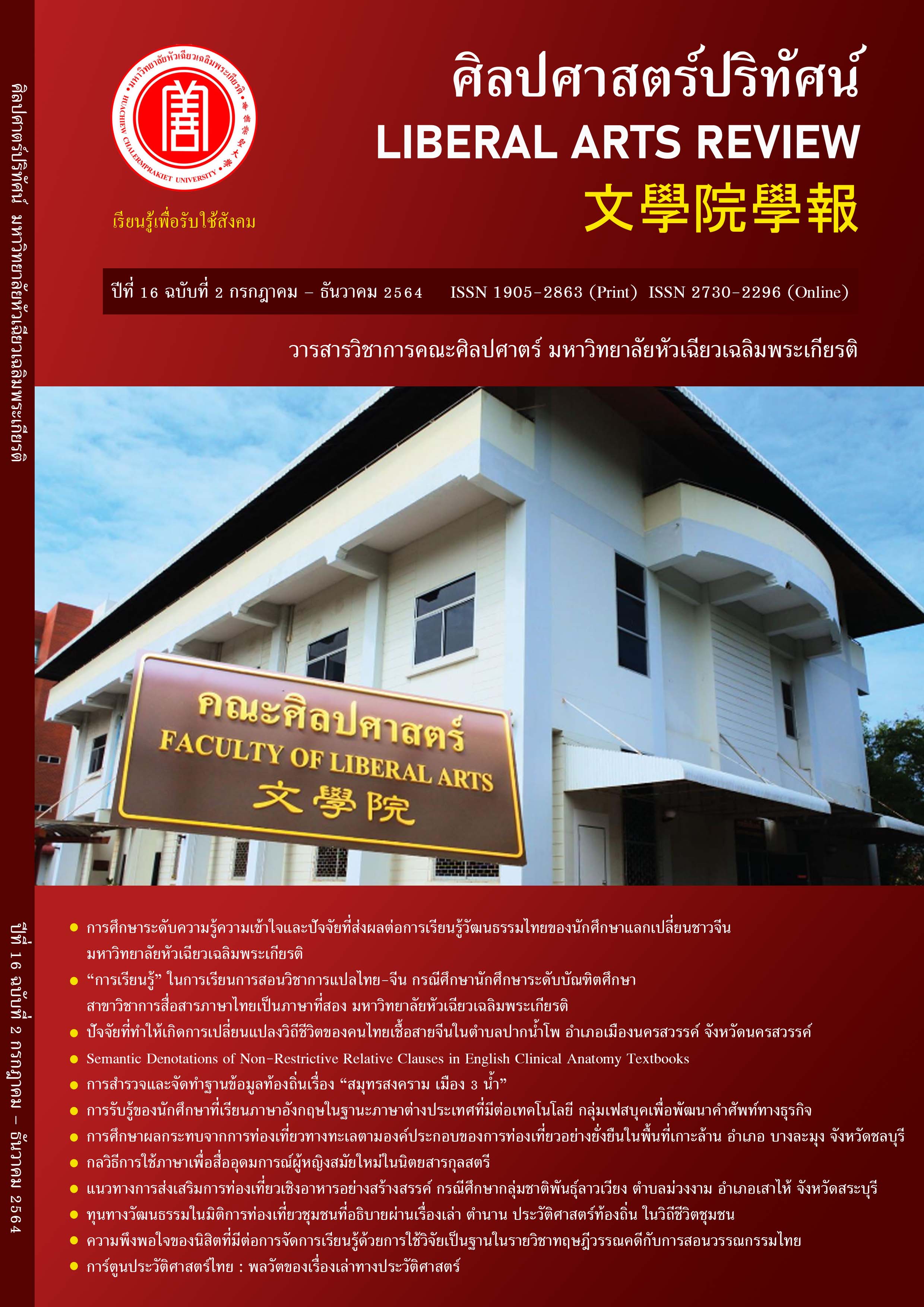"Learning" in Thai-Chinese Translation Teaching:
Based on A Survey Among of Undergraduate Majoring in Communicative Thai as a Second Language at Huachiew Chalermprakiet University
Keywords:
Thai-Chinese Translation Teaching, Theories of Translation, Translation teaching methodAbstract
This article focuses on the "learning" of students in Thai-Chinese translation teaching. A total of 122 valid questionnaires were collected from three grades of Chinese students majoring in Thai at Huachiew Chalermprakiet University. After the induction and analysis of the data, the following findings were obtained: 1. Most students do not have a good grasp of theories of translation. 2. Most students will not read through the original text before translation and will not proofread after translation. 3. Most students think that translation skills are not very helpful to their translation work. These findings have certain significance for both the "teaching" of teachers and the "learning" of students in Thai-Chinese translation teaching. For students, they should strengthen the study of translation theory knowledge, understand the original text before translation, and proofread after translation. For teachers, they should guide students to apply the theoretical knowledge to translation practice, help students form good proofreading habits, and require students to summarize and think in time, help students improve their translation ability.
References
วรรณา แสงอร่ามเรือง. (2542). ทฤษฎีและหลักการแปล. กรุงเทพมหานคร: โครงการตำราคณะอักษรศาสตร์ จุฬาลงกรณ์มหาวิทยาลัย.
สัญฉวี สายบัว. (2553). หลักการแปล. กรุงเทพมหานคร: สำนักพิมพ์มหาวิทยาลัยธรรมศาสตร์.
สุพรรณี ปิ่นมณี. (2562). แปลผิด แปลถูก คัมภีร์การแปลยุคใหม่. กรุงเทพมหานคร: สำนักพิมพ์แห่งจุฬาลงกรณ์มหาวิทยาลัย.
Cao, J. & Jin, Y. (2016). The Training Model of Translation Masters Driven by the Market: Take Northwest Normal University as an example. Chinese Translators Journal, 37(02), 50-55.
Dollerup, C. & Loddegaard, A. (Eds.). (1992). Teaching translation and interpreting: training, talent, and experience. Amsterdam: John Benjamins Publishing.
Feng, Y. H. (2001). Collaborative Translating Instruction on Classroom Net. Chinese Translators Journal, 22(2), 37-39.
Gao, M. X. & Wu, T. T. (2014). Study on Cultivating English Major Students’ Translation Capacity from Social Constructivism Perspective. Journal of Jilin Institute of Chemical Technology, 31(4), 5-25.
Gao, N. (2014). A New Exploration on Translation Teaching, Tianjin: Nankai University Press.
Ge, X. Q. (2015). A Case Study of Producers’ Control over the Translation of Paratext. Shandong Foreign Language Teaching, 36 (01), 96-101.
Hönig, H. G., & Kußmaul, P. (1982). Strategie der Übersetzung: Ein Lehr-und Arbeitsbuch (Vol. 205). Gunter Narr Verlag.
Kong, L. F. (2007). Some Experience in Teaching Translation. Journal of Changchun Finance College, (04), 66-68.
Lei, N. (2015). Investigation Report on Foreign Affairs Interpretation Requirements for MTI Teaching. Chinese Translators Journal, 36 (02), 49-52.
Li, X. S. & Ke, P. (2013). On Process-oriented Translation Teaching: Peer Review and Translation with Commentary. Foreign Language Education, 34(05), 106-109.
Mou, J. Z. & Shi, Q. M. (2002). On the Process-orientation of Translation Practice Course. Shandong Foreige Languages Journal, (05), 61-66.
Newmark, P. (1981). Approaches to Translation. Oxford: Pergamon Press.
Thai universities tap into rising Chinese demand. (4 สิงหาคม 2564). Reuters, Retrieved from URL. https://www.reuters.com/article/us-thailand-education-china-idUSKCN1PB07B.
Tytler, A. F. (1978). Essay on the Principles of Translation (1813): New edition (Vol. 13). Amsterdam: John Benjamins Publishing.
Wang, S. H. (2020). A review of Contra Instrumentalism: A Translation Polemic. Shandong Foreign Languages and Translation, 27 (02), 84-87.
Yang, Y. A. (2003). Teaching Translation Class in Guided Researching and Writing. Journal of Fuling Teachers College, 19(4), 125-128.
Zhang, L. J. (2019). Teaching English Translation in College. Course Education Research, (04), 103-104.
Downloads
Published
How to Cite
Issue
Section
License
บทความที่ได้รับการตีพิมพ์เป็นลิขสิทธิ์ของวารสารศิลปศาสตร์วิชาการและวิจัย
ข้อความที่ปรากฏในบทความแต่ละเรื่องในวารสารวิชาการเล่มนี้เป็นความคิดเห็นส่วนตัวของผู้เขียนแต่ละท่านไม่เกี่ยวข้องกับมหาวิทยาลัยหัวเฉียวเฉลิมพระเกียรติ และคณาจารย์ท่านอื่นๆ ในมหาวิทยาลัยฯ แต่อย่างใด ความรับผิดชอบองค์ประกอบทั้งหมดของบทความแต่ละเรื่องเป็นของผู้เขียนแต่ละท่าน หากมีความผิดพลาดใดๆ ผู้เขียนแต่ละท่านจะรับผิดชอบบทความของตนเองแต่ผู้เดียว




